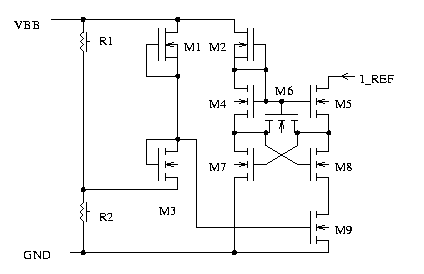Reference Current Generator
Basic Idea:
Creating a spread insensitive
current either requires trimming of resistors or a circuit where production
spread cancels. Trimming is expensive. Therefore this circuit attempts
to cancel the most frequent causes of spread.

M4, M5, M7, M8 are
a ring current generator similar to commonly known bipolar counterparts.
In stead of using a resistor M9 is operated in linear range (Vds<<Vgs).
M7 and M8 W/L ratio define the current flowing through M9. M2 is the starter.
A depletion transistor is advantageous but a high valued resistor would
do the same job.
Without long channel
transistor M6 there would be 2 additional weakly stable operating points:
1. M7 off, gate
of M8 floating high, M8 fully on.
2. M7 on, M8 off,
gate of M7 floating high.
These two undesired
operating points don't exist in the bipolar counterpart because the base
currents don't allow floating states. Adding long channel transistor M6
prevents these undesired operating points. Making M6 too short degrades
accuracy.
The voltage at the
source of M8 depends on:
1. The W/L ratio
between M8 and M7
2. The transconductance
gm of M7 and M8
Since gm is a function
of gate oxide thickness and of temperature the source voltage of M8 is
inverse proportional to gm and temperature.
Vs8 ~ 1/tox
Compensation:
To compensate the spread
of the source voltage of M8 a resistance proportional to gm and temperature
is needed. The current through M9 calculates as:
ID=0.5*k*(W/L)*[2*(Vgs-Vt)*Vds-Vds^2]
with k=u*Eox/tox
assuming Vds=Vs8<<Vgs
this equation can be approximated by:
ID=Vds*(W/L)*u*Eox*(Vgs-Vt)/tox
Provided M9 is driven
by Vgs9 = Vt+Vc with Vc being a constant voltage the gate oxide thickness
cancels. As long as the supply voltage is stable the drop across R2 is
about equal to Vc (assuming the current through R1 is much higher than
the current through M1).
